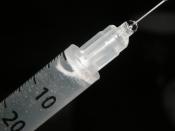Performance-Enhancing Drugs in Sports
Nicholas Griggs
Western International University
COM110
Lisa Johnson
Due Date: July 10, 2005
The representatives in Washington, D.C. now want to pass more anti-performance-enhancing drug legislation aimed at professional athletes and not at the school-aged athletes. On April 26, 2005, Rep. Cliff Stearns, R- Fla., the chief sponsor of the bill, and Rep. Fred Upton, R-Mich., co-sponsor of the bill, introduced the "Drug Free Sports Act." Of the five major items addressed in the bill, four apply to the punishment of pro-athletes while the fifth item only requires a study of the use of performance-enhancing drugs in college and high school. In 1990, federal legislation passed making anabolic steroids illegal without a prescription, resulting in heavy fines and jail time for users and dealers. These laws apply not only to the athletic world but also to all citizens of the United States. From the person who wants a better-looking beach body to the student researching a thesis paper.
If caught, the possibility of a fine and/or jail time exists Washington (Caile, 2005).
Getting the edge over the other person has made using performance-enhancing drugs a part of sporting events for centuries, but these drugs have only been banned from the Olympics since 1968. According to Ivan Waddington, author of Sports, Health and Drugs,
Performance-enhancing drugs have been used by people involved in sport and sportlike activities for some 2,000 years, but it is only recently (specifically, since the introduction of anti-doping regulations and doping controls from the 1960s) that this practice has been regarded as unacceptable. In other words, for all but the last three or four decades, those involved in sports have used performance-enhancing drugs without infringing any rules and without the practice giving rise to highly emotive condemnation and stigmatization (Sic) (Waddington 2000).
Advances in technology concerning performance-enhancing drugs have supported the assertion that these drugs threaten the purity of sports. Athletes long ago used stimulants and painkillers to gain an advantage in competition. During the 1950s, synthetic versions of testosterone, the male sex hormone, were developed and were given the name anabolic steroids. Coaches, trainers, team doctors, and athletes saw the positive results of using these steroids by allowing the athlete to train harder and become better than their natural abilities in a shorter amount of time. During this time of performance-enhancing discovery, there were no studies showing the health effects of long-term steroid use (Waddington 2000).
Led by the international Olympic movement, organized sport has attempted to prevent the use of performance-enhancing drugs by banning them; establishing testing programs and punishing athletes caught using prohibited substances. The International Olympic Committee laid down the basic anti-doping principles of sport in 1967:
1. "protection of the athletes' health";
2. "respect for medical and sports ethics"; and
3. "Ensuring an equal chance for everyone during competition" (International Olympic Committee).
It might seem hard to disagree with the first principle, "protection of athletes' health." Clearly, some performance-enhancing drugs are dangerous. Steroids, for example, are associated with a range of side effects, including heart attacks and liver cancer. Nevertheless, sports in general, and some sports in particular, are inherently dangerous. Athletes often injure themselves in training and in a ghoulish fashion. Indeed, for many people, it is the anticipation of witnessing injury and even death that makes sports events fun to watch. Think of automobile or downhill ski racing, even football and hockey, not to mention boxing. If athletes are free to accept a certain degree of risk from dangerous sports, why shouldn't they be allowed to accept a comparable, or even greater, risk from enhancements? An obvious answer is that the fact that some sports are already dangerous does not justify making them more so by allowing the use of dangerous enhancements. However, this begs the question of why enhancements should be singled out to ban. Why not require professional boxers to wear enormous protective helmets or to use much more highly cushioned gloves? Why not ban downhill ski racing, extreme sports, tackle football or rigid hockey sticks? The answer is that these actions would alter the fundamental nature of the sports. Nevertheless, that does not explain why we allow these sports to be fundamentally dangerous, or why risks from enhancements are deemed especially unacceptable.
Perhaps the answer lies in the assumption that the use of enhancements violates athletes' independence. We might feel less hostile to enhancements, for example, if athletes truly had a choice about whether or not to use them, but we know that if some athletes use them, they all will have to. Coaches have admitted that athletes must use doping to succeed at highly competitive levels of sport (Jeansonne, J. 1989).
The first sign athletes were using anabolic steroids was during the World Games in 1956 in Russia. In his book Drugs, Sports, and Politics, Robert Voy wrote that an American doctor named John B. Siegler, observed that Soviet athletes used urinary catheters because anabolic steroids had enlarged their prostates to the point that urination was difficult (Voy 1990).
In the 1970s and 1980s, 10,000 East German were training for the Olympics. One thousand of those athletes were given an anabolic steroid called Oral-Treunabol by their coaches and trainers. The athletes were told that the pills were vitamins and they would help their training. A few years later, male athletes suffered kidney failure and damaged hearts. Some of the hammer throwers died at a young age. Female athletes suffered ovarian cysts and birth defects to their children (Bechtel 25).
In 1998, the Tour de France was rocked by allegations that a large number of the athletes were consuming illegal performance-enhancing drugs a few days before the start of the race. The Tour de France is a body numbing, three-week bicycle race, which covers nearly 1,300 miles through the mountains of Ireland, France, and Belgium. A masseuse for France's Festina team, Willy Voet, was arrested after French police found a cash of illegal anabolic steroids when he attempted to enter France from Belgium. Follow-up investigations discovered the team's management and their doctor were supplying the riders with performance-enhancing drugs (Freudenrich).
The "Monitoring the Future" study conducted by the National Institute on Drug Abuse (NIAB) in 2002 determined that since 1991 there has been a significant increase of steroid use by school age children. This annual study surveys drug use among eighth, tenth, and twelfth graders in the United States. The first year data was collected on younger students was in 1991. Since 1991, there has been a significant increase in reported steroid use by teenagers. For all three grades, the 2002 levels represent a significant increase from 1991. In the 2002 survey, the youth were also asked how easy it was for school-aged children to obtain steroids. Twenty-two percent of eighth graders, 33.2 percent of tenth graders, and 46.1 percent of twelfth graders reported that steroids were "fairly easy" or "very easy" to obtain. A survey in 1999 determined that 479,000 students nationwide, or 2.9 percent, had used steroids by their senior year of high school. A survey in 2001 determined the percentage of 12th graders who believed that taking these drugs causes "great risk" to health declined from 68 percent to 62 percent. The Center for Disease Control and Prevention (CDC) conducts the Youth Risk Behavior Surveillance Study, a survey of high school students across the United States. A survey conducted in 2001 indicated that 5percent of all high school students reported lifetime use of steroid tablets/injections without a doctor's prescription. The survey also indicated that 5.8 percent of ninth graders, 4.9 percent of tenth graders, 4.3 percent of eleventh graders, and 4.3 percent of twelfth graders reported lifetime illegal use of steroids (National Institute on Drug Abuse). Based on projections from a nationally representative survey of 1,803 adults and youths in 2003 released by the Blue Cross and Blue Shield Association (BCBSA), approximately 1.1 million young people between ages 12 and 17 have taken potentially dangerous performance-enhancing supplements and drugs. The survey highlights just how seriously parents view the potential health threat, with 39 percent rating the use of performance-enhancing supplements and drugs as their number one concern in youth sports. Eighty-one percent of young people said they had never had a conversation with their parents about performance-enhancing substances, and 69 percent said they had received no information from their sports teams. Among the youth who knew someone using performance-enhancing drugs, 27 percent said these teens were taking the substances to "look better," an increase from 19 percent in 2001. In addition to illegal performance-enhancing drugs, many dietary supplement products available over-the-counter or on the Internet contain potentially dangerous ingredients, including androstenedione (andro) and ephedra. These products are not regulated nor tested by the Food and Drug Administration, and some have been reported to cause negative health consequences, including acne, kidney problems, reproductive difficulties and even death (Blue Cross-and Blue Shield Association).
Performance-enhancing drugs have entered one of America's favorite sporting events, NASCAR. According to the Greensboro News Record, NASCAR officials confirmed on April 6, 2005, 40 to 45 drugs tests have been conducted on drivers in the past two years. Driver Shane Hmile was suspended for testing positive for performance-enhancing drugs in September 2003. NASCAR is taking the use of performance-enhancing drugs very seriously and has tested Shane Hmile 12 to 15 times since he was reinstated in February 2004 and required him to attend counseling as part of his reinstatement.
Certainly, some of the blame for fostering substance use in athletes must be placed on sports cultures with misguided "win-at-all-costs" attitudes. Student athletes (teenagers) may not realize the health damages caused by illegal performance-enhancing drugs, but they are well aware of the pro athletes they admire. They see the outrageous paychecks they earn and the enormous money paid by sporting equipment companies for the athlete's endorsements. However, there is no distinctive enforcement of the current use by junior high, high school, and college youth, and the newest proposed legislation does not address these youths with any enforcement penalties. If today's society wants its youth to abstain from illegal performance-enhancing drugs just like pro athletes, then enforcement of the current statutes must be seriously enforced with clear, concise, consistent consequences.
References
Bechtel, Mark: Kennedy, Kostya: Swift, E.M. (2003, April 4). Bodies of Evidence (p25). Sports Illustrated.
Bill seeks to toughen drug testing in pro sports. (2005, April 27). The San Francisco Chronicle.
Freudenrich, Craig, PhD (unknown date). Performance Enhancing Drugs. Retrieved May 30, 2005, from http://www.enotes.com/performance-enhancing/.
International Olympic Committee, Fact sheet, The IOC Commission and the Fight Against Doping, July 26, 2001.
Jeansonne, J. 1989. "Ben's Doctor Is Next; Chemist Vows to Tell the Truth," Newsday, May 23, Sports section.
Long, Dustin (2005, April 7) Greensboro News Record. Greensboro, N.C. p C 6. Retrieved July 10, 2005, from Western International University library.
McCarthy, Shawn (2005, January 14). League of Fans' Position in the Use of Steroids and other Performance-Enhancing Substances in Sports. Retrieved May 30, 2005, from http//leagueoffans.org/drugsposition.html.
Monitoring the Future study conducted by the National Institute on Drug Abuse. Retrieved June 16, 2005, from http://www.nida.nih.gov/.
Survey conducted by the Blue Cross and Blue Shield Association (BCBSA) 2003, October 31.
Voy, Robert O. PhD (1990). Drugs, Sports, and Politics. Champaign, IL: Human Kinetics Publishers.
Waddington, Ivan (2002). Sports, Health, and Drugs: a Critical Sociolical Perspective. Florence, KY: Routledge.


